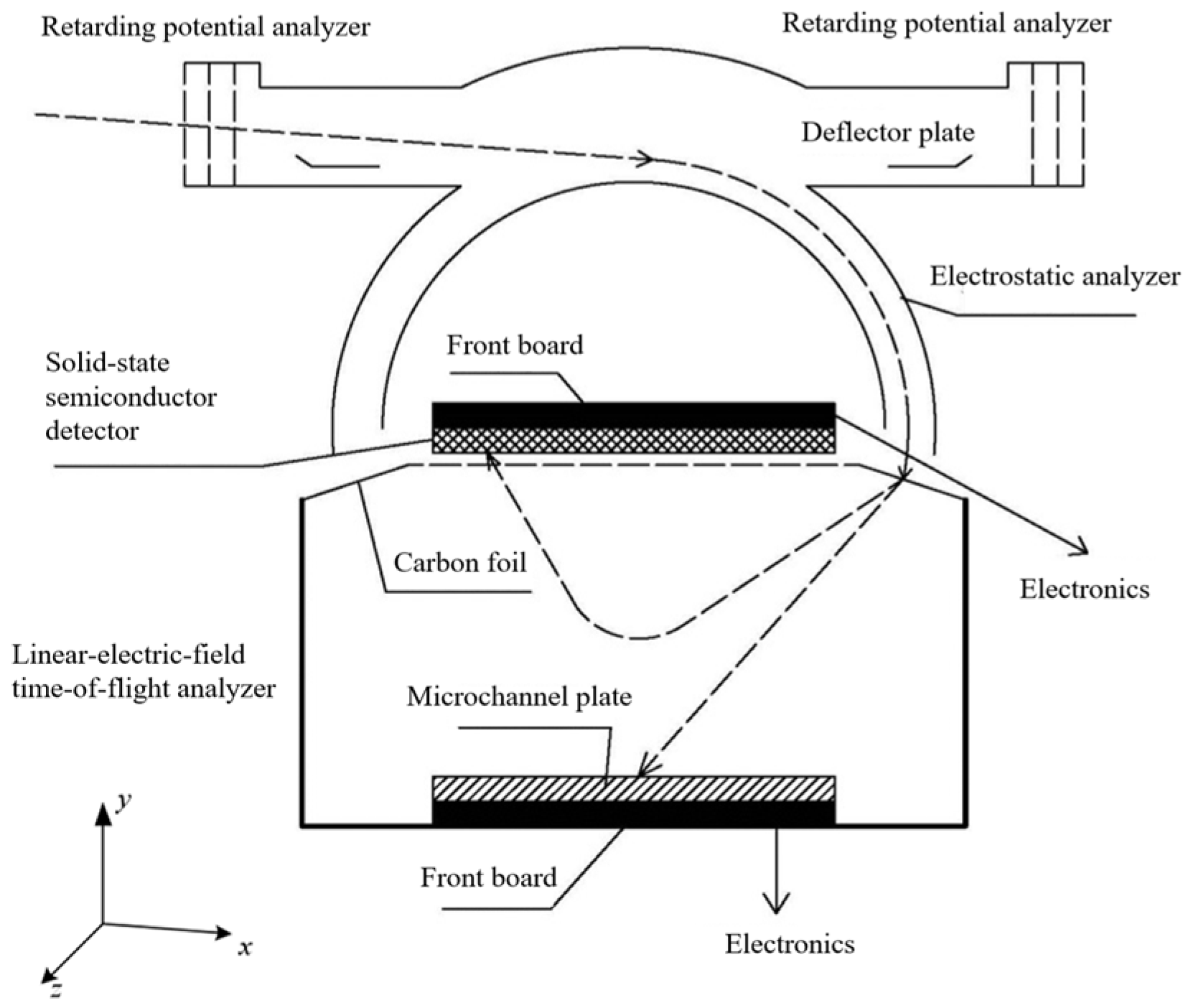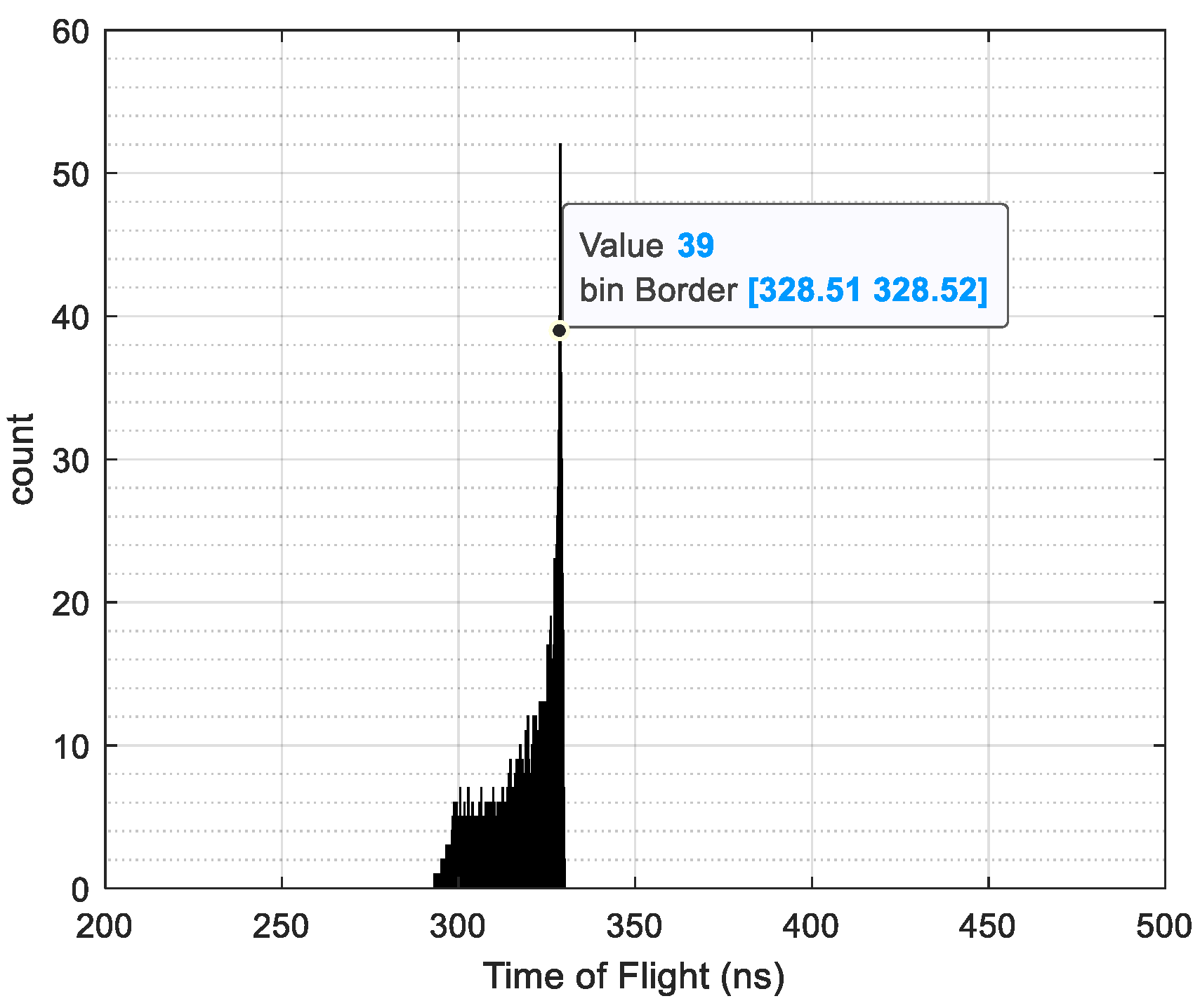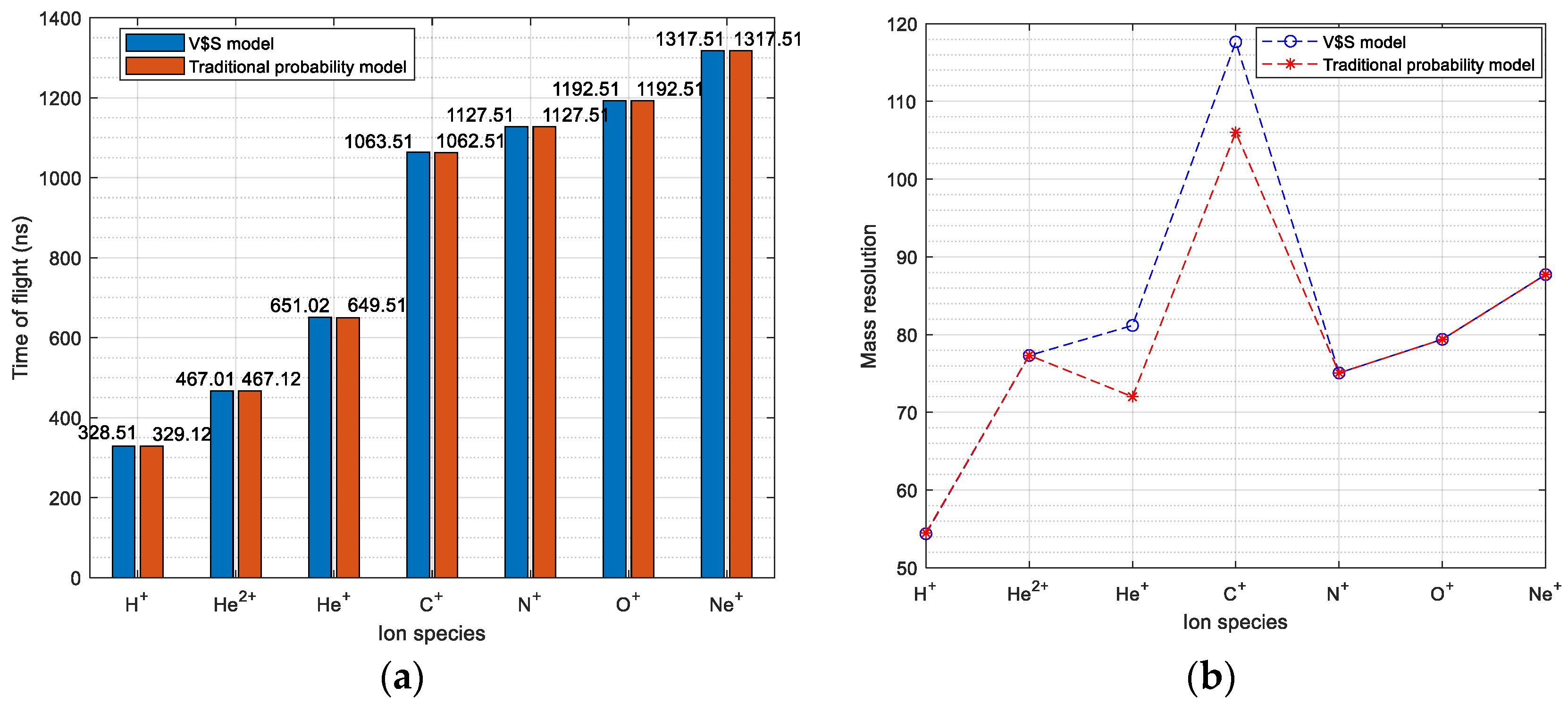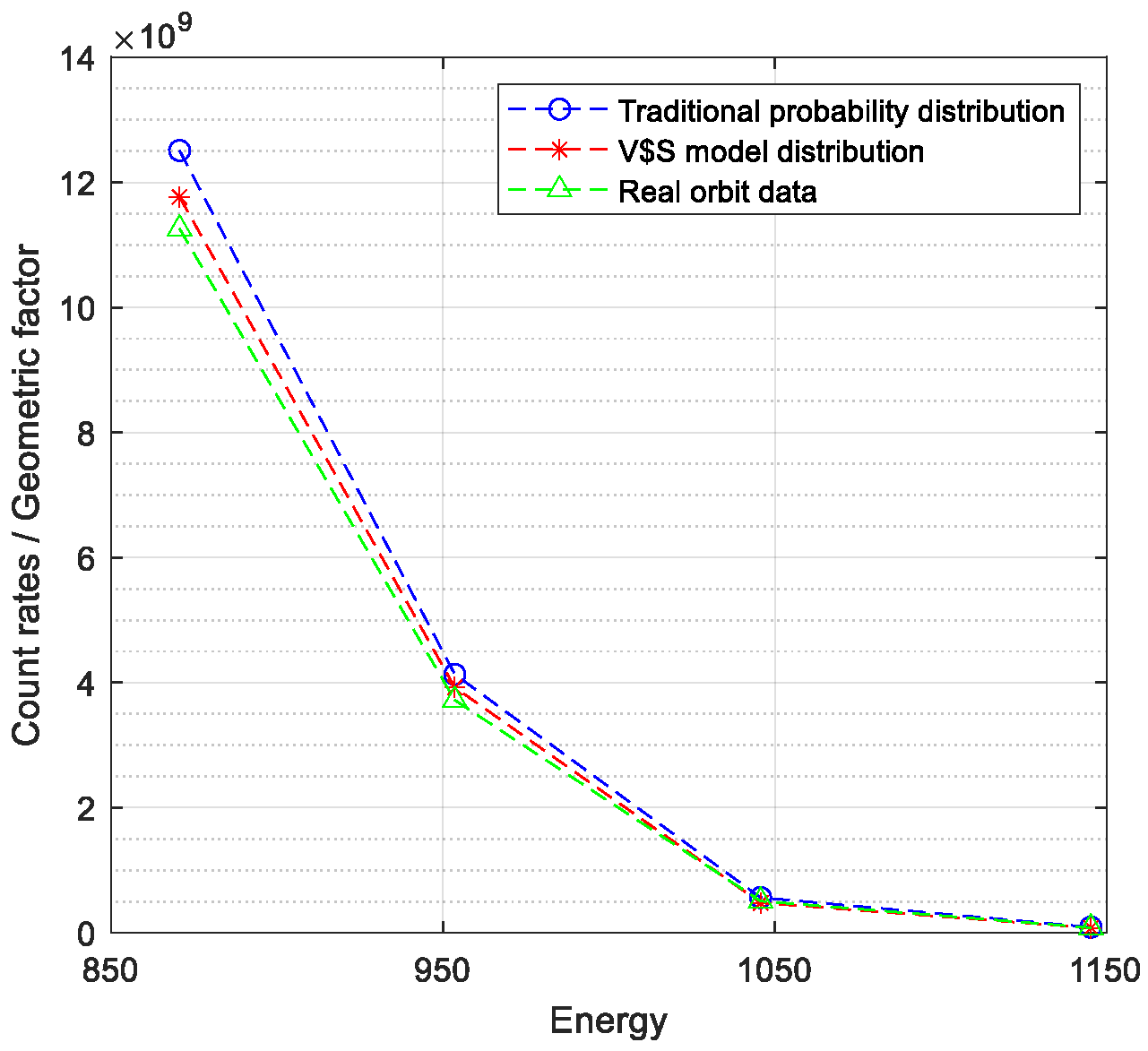A Comparative Analysis of Performance Simulation for PUI Detectors Based on Traditional Probability Model and the Vasyliunas and Siscoe Model
Abstract
1. Introduction
2. Essential Preliminaries
2.1. The Basic Detection Principle of the PUI Detector
2.2. The Simulation Process of the PUI Detector
3. Proposed Method
3.1. Mathematical Model of Ion Distribution
3.1.1. Traditional Probability Models
3.1.2. Vasyliunas and Siscoe Model
3.2. Detector Performance Indicators
3.2.1. Geometric Factor
3.2.2. Mass Resolution
3.3. Calculation Method of Count Rates
4. Experiment and Results
4.1. Comparison of Simulation Results between Traditional Models and the V–S Model
4.1.1. Geometric Factor Comparison
4.1.2. Mass Resolution Comparison
4.2. Comparison of Simulation Results with SWAP PUI Data
5. Conclusions and Future Work
Author Contributions
Funding
Institutional Review Board Statement
Informed Consent Statement
Data Availability Statement
Conflicts of Interest
References
- Gao, T.F. Study on the High-Resolution Detector for Outer Heliospheric Pickup Ions. Ph.D. Thesis, University of Chinese Academy of Sciences, Beijing, China, 2023. [Google Scholar]
- Schwadron, N.A.; McComas, D.J. Pickup Ions from Energetic Neutral Atoms. Astrophys. J. Lett. 2010, 712, L157–L159. [Google Scholar] [CrossRef][Green Version]
- Stilwell, D.E.; Joyce, R.M.; Teegarden, B.J.; Trainor, J.H.; Streeter, G.; Bernstein, J. The Pioneer 10/11 and Helios A/B cosmic ray instruments. IEEE Trans. Nucl. Sci. 2007, 22, 570–574. [Google Scholar] [CrossRef]
- Bridge, H.S.; Belcher, J.W.; Butler, R.J.; Lazarus, A.J.; Mavretic, A.M.; Sullivan, J.D.; Vasyliunas, V.M. The plasma experiment on the 1977 voyager mission. Space Sci. Rev. 1977, 21, 259–287. [Google Scholar] [CrossRef]
- Möbius, E.; Hovestadt, D.; Klecker, B.; Scholer, M.; Gloeckler, G.; Ipavich, F.M. Direct observation of He+ pick-up ions of interstellar origin in the solar wind. Nature 1985, 318, 426–429. [Google Scholar] [CrossRef]
- Bame, S.J.; Mccomas, D.J.; Barraclough, B.L.; Phillips, J.I.; Sofaly, K.J.; Chavez, J.C.; Goldstein, B.E.; Sakurai, R.K. The Ulysses solar wind plasma experiment. Astron. Astrophys. Suppl. Ser. 1992, 92, 237–265. [Google Scholar]
- Frank, L.A.; Ackerson, K.L.; Lee, J.A.; English, M.R.; Pickett, G.L. The plasma instrumentation for the Galileo Mission. Space Sci. Rev. 1992, 60, 283–304. [Google Scholar] [CrossRef]
- Hovestadt, D.; Hilchenbach, M.; Bürgi, A.; Klecker, B.; Laeverenz, P.; Scholer, M.; Neugebauer, M. CELIAS-charge, element and isotope analysis system for SOHO. Sol. Phys. 1995, 162, 441–481. [Google Scholar] [CrossRef]
- Gloeckler, G.; Cain, J.; Ipavich, F.M.; Tums, E.O.; Bedini, P.; Fisk, L.A.; Kallenbach, R. Investigation of the composition of solar and interstellar matter using solar wind and pickup ion measurements with SWICS and SWIMS on the ACE spacecraft. Space Sci. Rev. 1998, 86, 497–539. [Google Scholar] [CrossRef]
- Young, D.T.; Berthelier, J.J.; Blanc, M.; Burch, J.L.; Coates, A.J.; Goldstein, R.; Zinsmeyer, C. Cassini Plasma Spectrometer Investigation. Space Sci. Rev. 2004, 114, 1–112. [Google Scholar] [CrossRef]
- McComas, D.; Allegrini, F.; Bagenal, F.; Casey, P.; Delamere, P.; Demkee, D.; Weidner, S. The Solar Wind Around Pluto (Swap) Instrument Aboard New Horizons. Space Sci. Rev. 2008, 140, 261–313. [Google Scholar] [CrossRef]
- Galvin, A.B.; Kistler, L.M.; Popecki, M.A.; Farrugia, C.J.; Simunac, K.D.; Ellis, L.; Steinfeld, D. The plasma and suprathermal ion composition (Plastic) investigation on the stereo observatories. Space Sci. Rev. 2008, 136, 437–486. [Google Scholar] [CrossRef]
- Zhong, J.; Xie, L.; Zhang, H.; Li, J.X.; Pu, Z.Y.; Nowada, M.; Wang, S.J. Chang’e-1 observations of pickup ions near the moon under different interplanetary magnetic field conditions. Planet. Space Sci. 2013, 79–80, 56–63. [Google Scholar] [CrossRef]
- McFadden, J.P.; Kortmann, O.; Curtis, D.; Dalton, G.; Johnson, G.; Abiad, R.; Jakosky, B. Maven suprathermal and thermal ion compostion (static) instrument. Space Sci. Rev. 2015, 195, 199–256. [Google Scholar] [CrossRef]
- Goldstein, R.; Burch, J.L.; Mokashi, P.; Broiles, T.; Mandt, K.; Hanley, J.; Webster, J.M. The rosetta ion and electron sensor (IES) measurement of the development of pickup ions from comet 67p/c huryumov-gerasimenko. Geophys. Res. Lett. 2015, 42, 3093–3099. [Google Scholar] [CrossRef]
- McComas, D.J.; Alexander, N.; Allegrini, F.; Bagenal, F.; Beebe, C.; Clark, G.; White, D. The Jovian Auroral Distributions Experiment (Jade) On The Juno Mission To Jupiter. Space Sci. Rev. 2017, 213, 547–643. [Google Scholar] [CrossRef]
- Gao, T.F.; Kong, L.G.; Su, B.; Zhang, A. Design and simulation of the detector for outer heliosphere pickup ions. J. Beijing Univ. Aeronaut. Astronaut. 2021, 49, 367–377. [Google Scholar]
- Rodríguez-Pacheco, J.; Wimmer-Schweingruber, R.F.; Mason, G.M.; Ho, G.C.; Sánchez-Prieto, S.; Prieto, M.; Zong, Q. The Energetic Particle Detector: Energetic particle instrument suite for the Solar Orbiter mission. Astron. Astrophys. 2020, 642, A7. [Google Scholar] [CrossRef]
- Yu, D.J. Numerical simulation of a cylindrical electrostatic analyzer. Chin. J. Space Sci. 1999, 19, 61–68. [Google Scholar] [CrossRef]
- Kong, L.; Zhang, A.; Wang, S.; Sun, Y.; Zheng, X.; Dong, Y. Numerical Simulation Analysis of Space Plasma Detector Based on SIMION. Chin. Space Sci. Technol. 2012, 32, 71–76. [Google Scholar]
- Wuest, M.; Evans, D.S.; McFadden, J.P. Calibration of Particle Instruments in Space Physics; International Space Science Institute by ESA Communications: Noordwijk, The Netherlands, 2007. [Google Scholar]
- Vasyliunas, V.M.; Siscoe, G.L. On the flux and the energy spectrum of interstellar ions in the solar system. J. Geophys. Res. 1976, 81, 1247. [Google Scholar] [CrossRef]
- Chen, J.H.; Bochsler, P.; Möbius, E.; Gloeckler, G. Possible modification of the cooling index of interstellar helium pickup ions by electron impact ionization in the inner heliosphere. J. Geophys. Res. Space Phys. 2014, 119, 7142. [Google Scholar] [CrossRef]
- Chen, J.H.; Schwadron, N.A.; Möbius, E.; Gorby, M. Modeling interstellar pickup ion distributions in corotating interaction regions inside 1AU. J. Geophys. Res. Space Phys. 2015, 120, 9269. [Google Scholar] [CrossRef]
- McComas, D.J.; Zirnstein, E.J.; Bzowski, M.; Elliott, H.A.; Randol, B.; Schwadron, N.A.; Weaver, H. Interstellar Pickup Ion Observations to 38 au. Astrophys. J. Suppl. Ser. 2017, 233, 8. [Google Scholar] [CrossRef]
- McComas, D.J.; Swaczyna, P.; Szalay, J.R.; Zirnstein, E.J.; Rankin, J.S.; Elliott, H.A.; Weaver, H. Interstellar Pickup Ion Observations Halfway to the Termination Shock. Astrophys. J. Suppl. Ser. 2021, 254, 19. [Google Scholar] [CrossRef]
- McComas, D.J.; Shrestha, B.L.; Swaczyna, P.; Rankin, J.S.; Weidner, S.E.; Zirnstein, E.J.; Weaver, H.A. First High-resolution Observations of Interstellar Pickup Ion Mediated Shocks in the Outer Heliosphere. Astrophys. J. 2022, 934, 147. [Google Scholar] [CrossRef]
- Manura, D.J.; Dahl, D.A. SIMION 8.0 User Manual; Scientific Instrument Services, Inc.: Ringoes, NJ, USA, 2008. [Google Scholar]
- Michael, K. Monte Carlo methods in statistical physics: Mathematical foundations and strategies. Commun. Nonlinear Sci. Numer. Simul. 2010, 15, 1589–1602. [Google Scholar]
- Bundaleski, N.; Rakocevic, Z.; Terzc, I. Optical properties of the 127° cylindrical energy analyzer used in LEIS experiments. Nucl. Instrum. Methods Phys. Res. B 2002, 198, 208–219. [Google Scholar] [CrossRef]
- Cui, S.H.; Wei, Z.; Jian, H.; Li, X.T.; Chen, Q.H.; Guo, Y.X.; Wu, Z.Z. High-efficient particle-in-cell/Monte Carlo model for complex solution domain and simulation of anode layer ion source. Acta Phys. Sin. 2023, 72, 085202. [Google Scholar] [CrossRef]
- Jiao, Z.L.; Hu, S.L.; Jiang, L.X. General algorithm for calculating space environmental exposure flux based on Monte-Carlo ray tracing. Spacecr. Environ. Eng. 2019, 4, 350–356. [Google Scholar]
- Chase, L.M. The geometrical factor of large aperture hemispherical electrostatic analyzers. Rev. Sci. Instrum. 1973, 44, 998–1002. [Google Scholar] [CrossRef]
- Ziegler, J.F. SRIM-2003. Nucl. Instrum. Methods Phys. Res. Sect. B Beam Interact. Mater. At. 2004, 219–220, 1027–1036. [Google Scholar] [CrossRef]
- Randol, B.M.; McComas, D.J.; Schwadron, N.A. Interstellar Pick-Up Ions Observed between 11 and 22 AU by New Horizons. Astrophys. J. Suppl. Ser. 2013, 768, 120. [Google Scholar] [CrossRef]
- Elliott, H.A.; McComas, D.J.; Valek, P.; Nicolaou, G.; Weidner, S.; Livadiotis, G. The New Horizons Solar Wind Around Pluto (SWAP) Observations of the Solar Wind from 11-33 au. Astrophys. J. Suppl. Ser. 2016, 223, 19. [Google Scholar] [CrossRef]
- Nicolaou, G.; McComas, D.J.; Bagenal, F.; Elliott, H.A. Properties of plasma ions in the distant Jovian magnetosheath using Solar Wind Around Pluto data on New Horizons. J. Geophys. Res. Space Phys. 2014, 119, 3463–3479. [Google Scholar] [CrossRef]
- SWAP Count Rates Data. Available online: https://spacephysics.princeton.edu/missions-instruments/swap/pui-data-2021 (accessed on 13 May 2021).










| Experimental Calculation and Comparison Process |
|---|
| Begin Step 1: Select the V–S theoretical distribution model. Step 2: Input parameters such as r, θ, λ, etc. Step 3: Calculate parameters such as the number and energy of PUIs. Step 4: Generate .ion file data based on PUI parameters. Step 5: Input into SIMION for detector simulation. Step 6: Output information parameters such as particle number, pitch angle, energy, position, etc. Step 7: Perform data processing to calculate PUI detection performance indicators. Step 8: Calculate count rates. Step 9: Repeat the above steps by selecting traditional probability models. Step 10: Compare the output results of the two models with real orbital data. End |
| Parameter | Incident Ion Number | ESA Voltage (V) | RPA Voltage (V) | Energy Range (eV) | Pitch Angle Range (°) |
|---|---|---|---|---|---|
| Value | 1,000,000 | −235 | 0 | U (830, 1200) | U (−11, 0) |
| Parameter | Incident Ion Number | ESA Voltage (V) | RPA Voltage (V) | Energy Range (eV) | Pitch Angle Range (°) |
|---|---|---|---|---|---|
| Value | 1,554,876 | −235 | 0 | U (842.0325, 1069.171) | U (−11, 0) |
| Ion Type | Time of Flight (ns) | Time of Flight Half Height Width (ns) | Initial Energy E0/q (eV/e) | Energy E0 (eV) | Quantity of Electric Charge | Mass Number | Mass Resolution |
|---|---|---|---|---|---|---|---|
| H+ | 329.12 | 3.02 | 1013.4 | 1016.0588 | 1.0368 | 1.0997 | 54.4901 |
| He2+ | 467.12 | 3.02 | 2027.2 | 2032.2832 | 2.0057 | 4.4481 | 77.3377 |
| He+ | 649.51 | 4.51 | 1013.5 | 1016.1892 | 1.0029 | 4.3183 | 72.0078 |
| C+ | 1062.51 | 5.01 | 1012.7 | 1015.7998 | 1.0033 | 11.5741 | 106.0389 |
| N+ | 1127.51 | 7.51 | 1012.8 | 1015.8838 | 1.0033 | 13.0391 | 75.0672 |
| O+ | 1192.51 | 7.51 | 1013.0 | 1016.3168 | 1.0036 | 14.6238 | 79.3948 |
| Ne+ | 1317.51 | 7.51 | 1014.5 | 1017.5417 | 1.0033 | 17.7655 | 87.7170 |
| Ion Type | Time of Flight (ns) | Time of Flight Half Height Width (ns) | Initial Energy E0/q (eV/e) | Energy E0 (eV) | Quantity of Electric Charge | Mass Number | Mass Resolution |
|---|---|---|---|---|---|---|---|
| H+ | 328.51 | 3.02 | 993.4582 | 997.4629 | 1.0042 | 1.1119 | 54.3891 |
| He2+ | 467.01 | 3.02 | 2004.2 | 2010.6922 | 2.0069 | 4.4739 | 77.3195 |
| He+ | 651.02 | 4.01 | 994.2269 | 998.2393 | 1.0042 | 4.3640 | 81.1746 |
| C+ | 1063.51 | 4.52 | 993.6562 | 997.9728 | 1.0046 | 11.6772 | 117.6449 |
| N+ | 1127.51 | 7.51 | 994.1924 | 998.5700 | 1.0046 | 13.1567 | 75.0672 |
| O+ | 1192.51 | 7.51 | 994.1826 | 998.6534 | 1.0047 | 14.7346 | 79.3948 |
| Ne+ | 1317.51 | 7.51 | 994.7709 | 999.1730 | 1.0047 | 17.9262 | 87.7170 |
| Performance Indicators | Traditional Probability Model Results | V–S Model Results |
|---|---|---|
| Geometric Factor | 2.788 × 10−1 cm2·sr·eV/eV | 2.876 × 10−1 cm2·sr·eV/eV |
| Mass Resolution | ≥54.4901 | ≥54.3891 |
| Symbol | Value |
|---|---|
| 4.662×103 | |
| 16.0686 |
| Symbol | Value |
|---|---|
| 10AU | |
| /440 km/s | |
| 440 ± 1 km/s | |
| (5.6 ± 0.6) × 10−7/s | |
| 418 ± 1 km/s | |
| (252.2°, 9.0°) | |
| 0.1268 ± 0.0040(λ) ± 0.0033(method) 0.0011(stat.) cm−3 | |
| 3.8 ± 0.4au | |
| 0(x < 0), 1/2(x = 0), 1(x > 0) | |
| 22 km/s |
| Energy (eV) | Traditional Models | V–S Model | SWAP PUI Data |
|---|---|---|---|
| 870.6289 | 3.4877 × 103 ± 16.2347 | 3.0763 × 103 ± 14.3197 | 2.6270 × 103 ± 2.2931 |
| 953.5612 | 1.1520 × 103 ± 4.4702 | 1.0258 × 103 ± 3.9803 | 8.6772 × 102 ± 1.3179 |
| 1045.7081 | 1.5684 × 102 ± 0.5061 | 1.2521 × 102 ± 0.4040 | 1.1814 × 102 ± 0.4863 |
| 1145.2268 | 2.4993 × 101 ± 0.0672 | 2.0424 × 101 ± 0.0549 | 1.8825 × 101 ± 0.1941 |
Disclaimer/Publisher’s Note: The statements, opinions and data contained in all publications are solely those of the individual author(s) and contributor(s) and not of MDPI and/or the editor(s). MDPI and/or the editor(s) disclaim responsibility for any injury to people or property resulting from any ideas, methods, instructions or products referred to in the content. |
© 2024 by the authors. Licensee MDPI, Basel, Switzerland. This article is an open access article distributed under the terms and conditions of the Creative Commons Attribution (CC BY) license (https://creativecommons.org/licenses/by/4.0/).
Share and Cite
Cao, Y.; Zhang, Y.; Peng, X.; Xue, C.; Su, B. A Comparative Analysis of Performance Simulation for PUI Detectors Based on Traditional Probability Model and the Vasyliunas and Siscoe Model. Sensors 2024, 24, 6233. https://doi.org/10.3390/s24196233
Cao Y, Zhang Y, Peng X, Xue C, Su B. A Comparative Analysis of Performance Simulation for PUI Detectors Based on Traditional Probability Model and the Vasyliunas and Siscoe Model. Sensors. 2024; 24(19):6233. https://doi.org/10.3390/s24196233
Chicago/Turabian StyleCao, Yu, Yuzhu Zhang, Xiaodong Peng, Changbin Xue, and Bin Su. 2024. "A Comparative Analysis of Performance Simulation for PUI Detectors Based on Traditional Probability Model and the Vasyliunas and Siscoe Model" Sensors 24, no. 19: 6233. https://doi.org/10.3390/s24196233
APA StyleCao, Y., Zhang, Y., Peng, X., Xue, C., & Su, B. (2024). A Comparative Analysis of Performance Simulation for PUI Detectors Based on Traditional Probability Model and the Vasyliunas and Siscoe Model. Sensors, 24(19), 6233. https://doi.org/10.3390/s24196233





